The Aztecs: Mesoamerican Empire
Part 2: Zenith and Downfall As well, the Aztec civilization was known for its art. Aztec craftsmen and craftswomen excelled in the production of ceramics, sculpture, pottery, and textile works. One standout subset of Aztec art was works using feathers. Home life for the Aztec people was traditionally patriarchal. The father was the head of the household and was the primary worker outside the home, serving as a craftsman or a farmer or artist or merchant or perhaps as a soldier. The mother ran the household, preparing food and making clothing for the family. Children went to school and/or helped their mother with cooking and cleaning. 
People of limited means lived in thatched roof huts, outside which they grew flowers and vegetables. The sleeping area of the hut had mats on which people slept. Many huts also had shrines to the hundreds of gods to which the Aztec prayed and looked for guidance. Richer people lived in brick or stone homes, with many rooms. The supreme ruler lived in a giant palace. Games played by children included various educational and noneducational varieties, including a board game called Patolli for which players rolled dice to determine movement around the All of these people worshiped the many gods that made up the Aztec pantheon. The three groups of gods were gods of the sky and the heavens, gods of agriculture and weather, and gods of war and sacrifices. Various statues and temples throughout Tenochtitlan and beyond were dedicated to these gods. Among the most well-known gods and goddesses were these:
The Templo Mayor, central temple in the capital city, was the location for many major ceremonies. A common ritual practice during such ceremonies was the spilling of blood, either voluntarily (in a process known as bloodletting) or involuntarily (in the form of human sacrifice). 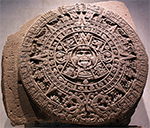
Keeping track of the various religious rituals and, indeed, of the days and weeks of the year was the Aztec Calendar, which had at its heart a 365-day cycle (xiuhpohualli) but also a ritual cycle of 260 days (tonalpohualli). The 365-day calendar had 18 months having 20 days; the last five days of the year were sort of remainder days. The two calendars reconciled every 52 years, and the Aztecs celebrated that event with the New Fire Ceremony. Warfare was a way of life for the Aztecs. They fought with clubs, spears, and swords and wore armor, helmets, and shields. Significantly, the weapons were made of wood or obsidian–thus, not made of metal. 
The Aztec ruler from 1440 was Moctezuma I, who began his reign by stamping his authority on his empire by putting down rebellions in states that did not want to pay the central tax. Moctezuma's uncle, Itzcoatl (left), had led the war effort to defeat the Tepanec. Itzcoatl's grandson Axayacatl (who was also Mocetzuma's son-in-law) was next on the Aztec throne, beginning in 1469. He, too, embarked on a coronation campaign, conquering more and more of the surrounding lands. His death in 1481 brought his older brother Tizoc to the throne. This ruler had less success in his initial battles and died under mysterious circumstances just four years into his reign. 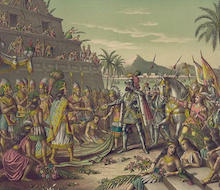
Another brother, Ahuitztl, became ruler and had success in subjugating neighboring states. He had enlarged the Templo Mayor and also ordered construction of other major projects. The death of Ahuitztl, in 1502, brought to the throne his nephew, Moctezuma II. This was the ruler who initially welcomed the Spaniards (right) and then died regretting it. One of the neighboring states that the Aztecs never managed to conquer fully was Tlaxcala. It was this power that Hernán Cortés and his men befriended and allied with on their march to Tenochtitlan. The Spaniards arrived in 1519 and, two years later, conquered the Aztecs, laying waste to Tenochtitlan and to the rest of the empire, through a combination of superior weaponry and firepower and the spreading of European diseases for which the Native Americans had neither immunity nor cure. 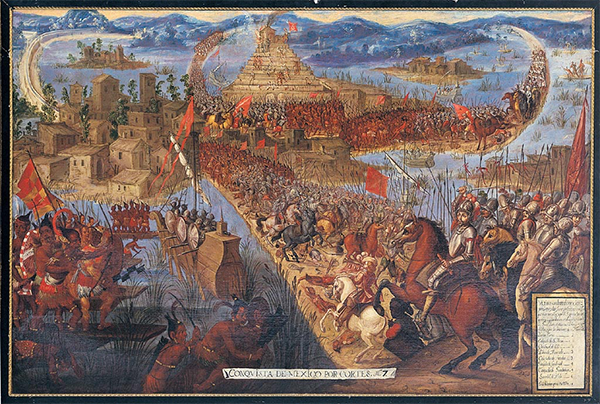
First page > Foundation and Empire > Page 1, 2
|
|
Social Studies for Kids
copyright 2002–2025
David White



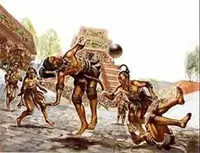 board. A more competitive game played by children and adults was Ullamalitzli, a game played on a court and featuring a rubber ball that competitors used their heads, shoulders, hips, and knees to pass to other competitors and, ultimately, coax through a stone ring. Such a game had been played by their Mesoamerican predecessors the Maya.
board. A more competitive game played by children and adults was Ullamalitzli, a game played on a court and featuring a rubber ball that competitors used their heads, shoulders, hips, and knees to pass to other competitors and, ultimately, coax through a stone ring. Such a game had been played by their Mesoamerican predecessors the Maya.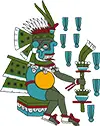 Cinteotl: god of maize (corn)
Cinteotl: god of maize (corn)
